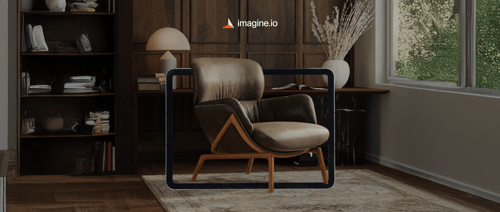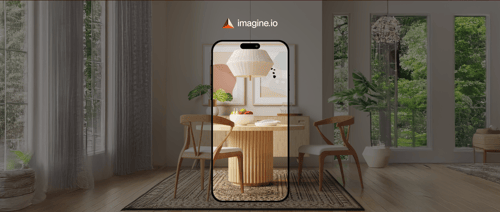If you’re still relying on traditional photography to bring your products to life online, it might be time to rethink your content strategy. The way we market, sell, and visualize products has undergone a radical transformation. At the heart of this shift is one powerful innovation: 3D rendering.
Once confined to gaming and movies, 3D visualization has now become the silent backbone of modern product marketing. And it’s quietly replacing conventional photography in every industry—from furniture and fashion to electronics and home décor.
Let’s talk about why this shift is happening, what it means for your brand, and how embracing virtual photography isn’t just smart—it’s essential.
Get the latest updates straight to your inbox.
By clicking sign up you'll receive occasional emails from imagine.io. You always have the choice to unsubscribe within every email you receive.
Traditional Product Photography: Beautiful, But Broken
There’s no doubt traditional eCommerce product photography has its charm. The textures, the lighting, the realism—it works. But behind every polished product image lies a complex, time-consuming, and expensive process. Think about it:
- Physical prototypes must be ready
- Logistics for photoshoots across multiple locations
- Set designers, photographers, stylists, editors, and post-production work
- Multiple rounds of approval and reshoots for every product variation
And if your brand offers a product with hundreds of color or material options? Multiply that chaos exponentially. The truth is traditional photography simply wasn’t built for scale or speed.
Enter 3D Rendering: A Scalable, Future-Proof Alternative
3D rendering flips the script on how we approach product visuals. It doesn’t just replicate photography—it reinvents it. At its core, 3D rendering uses digital models to create hyper-realistic product visuals. Once a model is created, it can be visualized in any environment, from any angle, with any lighting, background, or material. Here’s why that matters for your business:
1. Cost-Efficiency at Scale

Forget the costs of setting up studios, hiring crews, and transporting inventory across cities. With 3D, your visual production goes entirely digital. That means:
- No need for physical prototypes
- Drastically reduced reshoot costs
- One 3D model = infinite variations
In fact, a report from CGI Furniture shows that 3D rendering can reduce visual production costs by 20% year over year compared to traditional photography, especially for large product catalogs.
2. Unmatched Speed to Market
Need to launch a product before the prototype is even finalized? With virtual photography, that’s possible. Digital renders allow marketing and product teams to move in parallel with manufacturing. According to a study, businesses using 3D/AR content see a 40% reduction in time-to-market compared to traditional workflows. Some imagine.io customers have cut their visual production time from months to days—without compromising quality.
3. Customization Made Easy
Modern buyers want more than just options—they want personalization. 3D rendering makes customization effortless. With virtual models, you can:
- Display every color, fabric, or finish dynamically
- Allow customers to configure products in real-time
- Enable true-to-life AR previews directly in the buyer’s space
A research found that 71% of consumers say they’re more likely to buy from a brand that offers interactive 3D and AR experiences.
4. Consistency Across Channels
When your visuals are generated from the same 3D source files, consistency becomes the default—not an afterthought. Whether it's your website, Amazon listing, social media ad, or print catalog, your brand identity remains intact across all touchpoints. This alignment boosts buyer trust and sharpens your professional edge.
Plus, a study from Salsify revealed that 87% of shoppers say product content is “extremely or very important” to their purchase decision—so consistent, high-quality visuals aren’t a luxury; they’re a conversion driver.
5. Sustainability That Speaks to Modern Values
Sustainability isn’t just a buzzword—it’s a business imperative. By going virtual, you're minimizing the carbon footprint that comes from:
- Manufacturing samples
- Shipping products to photoshoots
- Disposing of props and sets
Digital rendering is a greener, more responsible approach—something that increasingly matters to both customers and stakeholders.
Real-World Adoption: Why Leading Brands Are Making the Switch

This shift isn’t theoretical. Brands like IKEA, Target, and Wayfair are already investing heavily in 3D rendering—not just as a creative upgrade, but as a strategic necessity. These companies manage massive product catalogs with countless variations in color, size, and material. Traditional photography simply can't keep up. With 3D assets, they can quickly generate on-brand, high-quality visuals at scale, without the delays and costs of physical photoshoots.
More importantly, they’re enhancing the customer experience. 3D enables interactive product views, real-time customization, and immersive AR features—all of which help online shoppers feel more confident and connected. For these brands, 3D isn’t just about better visuals—it’s about future-proofing how they sell, market, and engage.
The imagine.io Perspective
While the shift toward virtual photography is industry-wide, platforms like imagine.io are helping brands make that leap with less friction. By combining 3D rendering, AI automation, lifestyle generation, 360° spins, and AR tools in one place, imagine.io empowers creative teams to:
- Work faster
- Reduce operational costs
- Deliver higher-quality content
- Unlock new customer experiences
But here’s the key—it’s not about replacing your creative process. It’s about scaling it smartly.
Final Thoughts: The Future is (Already) Here
Virtual photography isn’t a prediction anymore—it’s the new standard. As expectations for visual content continue to evolve, sticking with old-school photoshoots could be the thing holding your team back.
Whether you're selling one product or a thousand, the ability to produce on-brand, hyper-realistic visuals at scale will define your competitive edge. 3D rendering is how you get there. Ready to see what virtual photography can do for your brand? Book a demo with us and let us show you how to transform your visual strategy with powerful, scalable 3D technology.


.gif?width=1296&height=1296&name=Untitled%20design%20(8).gif)



.png?width=500&name=How%20to%20Add%20a%203D%20Product%20Configurator%20to%20Your%20WordPress%20Website%20(Complete%20B2B%20Guide).png)
















%20(1).png?width=500&name=Why%20Exploded%20Mattress%20Views%20Matter%20(And%20How%20to%20Generate%20Them)%20(1).png)
.png?width=500&name=Best%20Shopify%20Product%20Configurator_%20How%20to%20Choose%20the%20Right%20One%20(2).png)
.png?width=500&name=Why%20Exploded%20Mattress%20Views%20Matter%20(And%20How%20to%20Generate%20Them).png)



.png?width=500&name=Best%20Shopify%20Product%20Configurator_%20How%20to%20Choose%20the%20Right%20One%20(1).png)







.png?width=500&name=How%203D%20Rendering%20Can%20Make%20or%20Break%20Your%20Industrial%20Design%20Pitch%20(1).png)








%20with%20Digital%20Twins%20and%203D%20Visualization.png?width=500&name=Optimizing%20Your%20Digital%20Asset%20Management%20(DAM)%20with%20Digital%20Twins%20and%203D%20Visualization.png)




.png?width=500&name=Styling%20Home%20Decor%20for%202025_%20From%20Global%20Influences%20to%20Playful%20Personalization%20(1).png)

